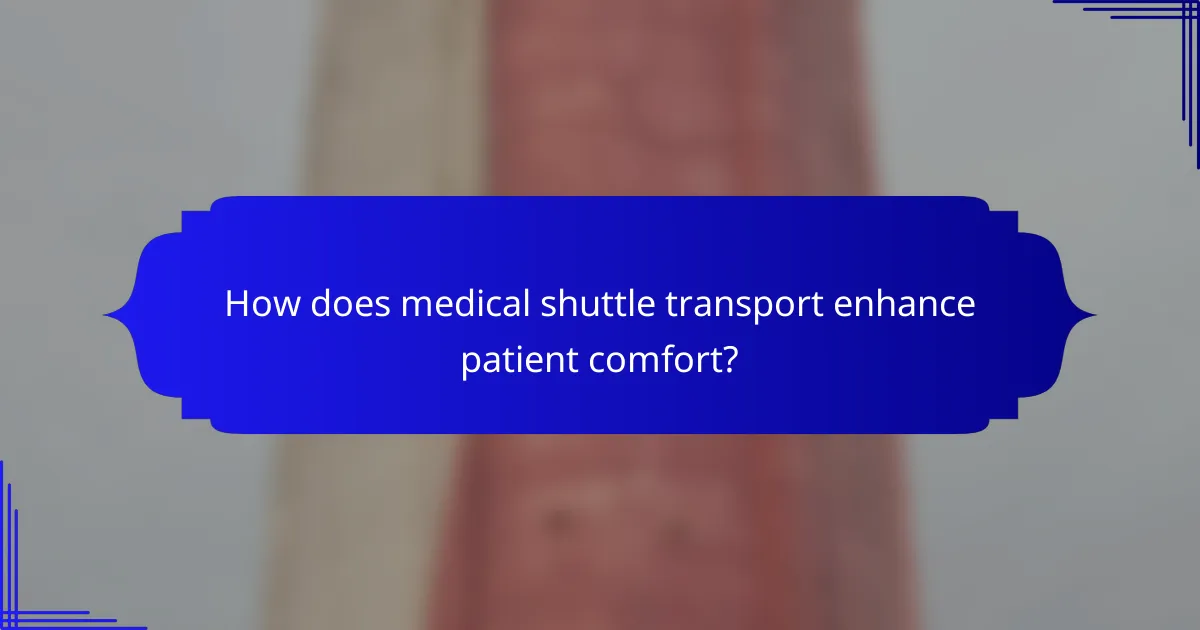Medical shuttle transport is designed to enhance patient comfort by utilizing specialized vehicles that prioritize safety and ease during travel. These services cater to various medical needs, ensuring a supportive experience from pickup to drop-off. Additionally, insurance coverage for medical shuttles can vary widely, making it essential for patients and caregivers to understand the specifics of their plans to ensure adequate support for transportation costs.

How does medical shuttle transport enhance patient comfort?
Medical shuttle transport enhances patient comfort by providing specialized vehicles designed for safety and ease during travel. These services prioritize the needs of patients, ensuring a smooth and supportive experience from pickup to drop-off.
Comfortable seating arrangements
Medical shuttles are equipped with comfortable seating that accommodates patients’ needs, often featuring adjustable seats and ample legroom. This design helps reduce discomfort during transit, especially for those with chronic pain or mobility issues.
Some services offer reclining seats or additional cushioning, which can significantly improve the travel experience for patients who may need to rest or relax during their journey.
Climate control features
Effective climate control is essential in medical shuttles to maintain a comfortable environment for passengers. These vehicles typically have heating and air conditioning systems that can be adjusted according to individual preferences.
Maintaining a stable temperature can be particularly important for patients with specific medical conditions, ensuring they remain comfortable throughout their transport.
Personalized care during transport
Medical shuttle services often provide trained personnel who offer personalized care during the journey. This may include assistance with mobility, medication management, or simply providing reassurance and companionship.
Having a caregiver on board can help alleviate anxiety and ensure that patients feel secure and supported, making the transport experience more pleasant.
Accessibility for mobility-impaired patients
Accessibility is a key feature of medical shuttle transport, with vehicles designed to accommodate mobility-impaired patients. Ramps, lifts, and spacious interiors allow for easy entry and exit, making travel safer for those using wheelchairs or other mobility aids.
These features ensure that all patients, regardless of their physical limitations, can access necessary medical services without undue stress or difficulty.
Emergency medical equipment availability
Many medical shuttles are equipped with essential emergency medical equipment, such as oxygen tanks, first aid kits, and defibrillators. This readiness helps ensure patient safety during transport, particularly for those with serious health conditions.
Having access to emergency equipment provides peace of mind for both patients and their families, knowing that immediate assistance is available if needed during the journey.

What specialized transport options are available in the UK?
In the UK, specialized transport options for patients include non-emergency medical transport services, ambulance services for critical care, and vehicles designed for wheelchair users. These services cater to various medical needs, ensuring patient comfort and safety during transit.
Non-emergency medical transport services
Non-emergency medical transport (NEMT) services provide transportation for patients who do not require immediate medical attention but need assistance getting to medical appointments. These services typically include scheduled rides in comfortable vehicles with trained drivers who can assist passengers as needed.
When considering NEMT, check if your healthcare provider or insurance covers the costs. Many providers offer these services for routine visits, such as check-ups or therapy sessions, making them a convenient option for patients with mobility challenges.
Ambulance services for critical care
Ambulance services for critical care are essential for patients experiencing emergencies or requiring urgent medical attention. These services are equipped with advanced medical equipment and staffed by trained paramedics who can provide immediate care during transport.
In the UK, emergency ambulance services are typically funded through the National Health Service (NHS). If you need to use an ambulance for non-emergency situations, be aware that costs may apply, and it’s advisable to check with your insurance provider regarding coverage.
Specialized vehicles for wheelchair users
Specialized vehicles for wheelchair users are designed to accommodate individuals who rely on wheelchairs for mobility. These vehicles feature ramps or lifts for easy access and secure tie-downs to ensure safety during transit.
When arranging transport, confirm that the service provider has vehicles specifically equipped for wheelchair users. This ensures a comfortable and safe journey, especially for longer trips to medical facilities or rehabilitation centers.

How is insurance coverage structured for medical shuttles?
Insurance coverage for medical shuttles varies significantly between providers, often depending on the type of transport and the patient’s medical needs. Generally, both public and private insurers may cover some costs, but understanding the specifics is crucial for patients and caregivers.
Coverage by NHS and private insurers
The NHS typically covers medical transport for patients who require assistance due to medical conditions, provided that the transport is deemed medically necessary. Private insurers may also cover medical shuttle services, but the extent of coverage can depend on the individual policy and the patient’s circumstances.
Patients should check with their specific insurance provider to understand the details of their coverage, including any pre-approval requirements and the types of medical transport that qualify for reimbursement.
Common exclusions in policies
Many insurance policies have exclusions that can affect coverage for medical shuttles. Common exclusions include transport for non-emergency situations, services provided by non-licensed transport companies, and trips that are not pre-approved by the insurer.
Patients should carefully review their policy documents to identify any exclusions and ensure that their planned transport aligns with their coverage to avoid unexpected out-of-pocket costs.
How to file a claim for transport costs
Filing a claim for medical shuttle costs typically involves submitting a claim form along with supporting documentation, such as receipts and a letter from a healthcare provider justifying the need for transport. Each insurer may have its own process, so it’s essential to follow the specific guidelines provided by the insurance company.
To streamline the claims process, patients should keep detailed records of their transport, including dates, times, and the nature of the medical service received. This documentation can help substantiate the claim and increase the likelihood of approval.

What are the prerequisites for using medical shuttle services?
To utilize medical shuttle services, patients typically need a doctor’s referral and must meet specific eligibility criteria. These prerequisites ensure that the transport is medically necessary and appropriate for the patient’s condition.
Doctor’s referral requirements
Most medical shuttle services require a referral from a licensed healthcare provider. This referral should outline the patient’s medical condition and the necessity for specialized transport. It’s advisable to check with the shuttle service beforehand to confirm the specific documentation needed.
In some cases, the referral may need to include details about the patient’s mobility limitations or any special medical equipment required during transport. Ensuring that the referral is comprehensive can help avoid delays in scheduling the shuttle service.
Eligibility criteria for patients
Eligibility for medical shuttle services often depends on the patient’s health status and the nature of their medical needs. Generally, these services are designed for individuals who require assistance due to mobility issues, chronic illnesses, or post-operative recovery.
Patients may also need to provide proof of insurance coverage, as many shuttle services work directly with health insurance providers. It’s important to verify whether the service is covered under the patient’s plan, which can vary by provider and region.

How to choose the right medical shuttle service?
Choosing the right medical shuttle service involves evaluating various factors such as reputation, pricing, and safety standards. Prioritize services that specialize in patient transport and have a proven track record of reliability and comfort.
Evaluating service providers’ reputation
Start by researching the reputation of medical shuttle services in your area. Look for online reviews, testimonials, and ratings from previous clients to gauge their reliability and quality of service.
Consider asking for recommendations from healthcare professionals or local hospitals, as they often have experience working with specific shuttle providers. A strong reputation often indicates a commitment to patient comfort and safety.
Comparing pricing structures
Pricing for medical shuttle services can vary widely, so it’s essential to compare different providers. Some may charge a flat fee, while others might have hourly rates or additional costs based on distance or specific services required.
Check if the service accepts your insurance plan, as this can significantly affect your out-of-pocket expenses. Don’t hesitate to ask for a detailed breakdown of costs to avoid unexpected charges.
Assessing vehicle safety standards
Safety is a critical factor when selecting a medical shuttle service. Ensure that the vehicles are well-maintained and meet local safety regulations. Look for services that conduct regular inspections and have a clear maintenance history.
Inquire about the qualifications of the drivers, including any specialized training in patient transport. A service that prioritizes safety will often provide vehicles equipped with necessary medical equipment and comfortable seating arrangements for patients.

What are the benefits of using medical shuttles over traditional transport?
Medical shuttles offer significant advantages over traditional transport by prioritizing patient comfort and specialized care. These services are designed to reduce stress and enhance the overall experience for patients requiring medical attention.
Reduced waiting times for patients
Medical shuttles typically feature streamlined scheduling and dedicated routes, which can lead to reduced waiting times compared to standard transport options. Patients often experience shorter delays, allowing for timely arrivals at medical appointments.
For instance, while traditional transport may involve multiple stops or detours, medical shuttles focus on direct routes to healthcare facilities. This efficiency can save patients valuable time, especially when dealing with urgent medical needs.
Specialized training for drivers
Drivers of medical shuttles undergo specialized training to handle the unique needs of patients, including those with mobility challenges or medical conditions. This training ensures that drivers are equipped to provide safe and compassionate support during transport.
Additionally, many medical shuttle services emphasize customer service skills, enabling drivers to assist patients effectively. This focus on training helps create a more comfortable and reassuring environment for individuals who may be anxious about their medical journeys.
